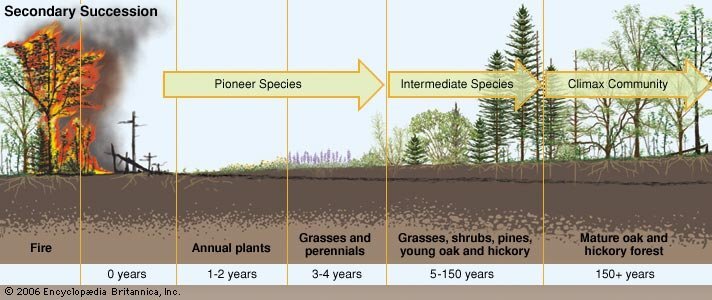The First Steps to Wildfire Recovery: Pioneer Fungi
Wildfires are infamous for their destruction, but they play an important role in the life cycle of an ecosystem and can lead to new growth and diversity. This is known as ecological succession, the process by which an ecological community changes over time. After a burning event, when the system is decimated, the first organisms to reappear in the harsh new landscape are referred to as pioneer species. Saprophytic fungi species like those in the Anthracobia and Pyronema genus react to fire by creating spores and increasing decomposition activity. Within the first few weeks after a fire, pioneer fungi will eat through any remaining trees and logs, breaking them down into nutrients that become available for other pioneer species to utilize in their regrowth.
Source: Britannica (Secondary Succession)
Besides the fungi eating up dead trees and sprouting above ground, there are important things going on in the soil. In a healthy forest, soil fungi acts like a nutrient network between plants and trees, sustaining and facilitating growth. Saprophytes are the types of fungi that break down and distribute carbon into the soil, while mycorrhizal fungi form a symbiotic relationship with plants to deliver them nutrients. In fires, the high heat can kill fungal species, but a study found that this only occurs down to a depth of about 4 inches--beyond that depth, there is little difference in the composition of soil fungi before and after the burning event. This may be why fungi is such an effective ecosystem pioneer: it already has a foundation, so it recovers in the topsoil relatively quickly compared to other plants and trees that take years to re-establish themselves in the community.
A yummy example specific to the conifer forests of the western US is that following a fire, you can reliably count on patches of morels to pop up. Especially in the first year after the fire, huge bunches of morels will appear--one study of Yosemite National Park fires estimated that in an average year following a burn, more than one million morels will be produced. The ash and charcoal of a forest fire are the perfect growing conditions for morels, and they turn destruction into deliciousness.
Source: Fire Morels 2013, photographed by Daniel Winkler of Mushroaming
The ultimate role of pioneer fungi species in a post-wildfire ecosystem is to eliminate detritus and enrich the soil, preparing a forest for new growth and productivity. The growth of fungi is one of the first and most important steps of ecosystem recovery, and can be viewed as evidence of the resilience of nature, even under the most catastrophic circumstances.
Sources
https://tfsweb.tamu.edu/EvidenceofRecovery/ “Fire Danger: The First Evidence of Recovery: Fungus” - Texas A&M Forest Service
https://blogs.scientificamerican.com/artful-amoeba/in-the-year-following-fire-a-mushroom-bonanza/ “In the Year Following Fire, A Mushroom Bonanza” - Scientific American
https://eco-intelligent.com/2016/11/22/ecological-succession-who-starts-it-pioneer-species/ “All you need to know about pioneer species” by Saurab Babu for Eco-Intelligent
https://www.fs.fed.us/pnw/sciencef/scifi207.pdf “The Recovery of Soil Fungi Following a Fire” - USDA Forest Service
https://www.anbg.gov.au/fungi/ecology-fire.html “Fungal Ecology: Fungi and Fire” - Australian National Botanic Gardens

